In order to play the accordion, you should learn how to read music, you need to know how to read the treble and the bass clef. In fact, accordion notation is similar to piano notation, both use the double staff, the treble staff for the right hand, and the clef staff for the left hand. Playing accordion without reading music could be extremely difficult but don’t worry, although you may think, learning to read notes is quite easy and the accordion notation is simple.
Accordion notation
Accordion notation is the system used to write music specifically for the accordion. It’s very similar to standard piano notation, but it includes some simplifications due to the unique features of the Stradella bass system.
Accordion Notation Basics
Usually, it’s written on a double staff with the right hand melodies on the treble clef and the left hand accompaniment on the bass clef. Through the use of staff lines and various symbols, the musician is able to understand the pitch, duration, dynamics, timbre, and rhythm of the music, allowing for a precise and expressive performance.
The Treble and Bass Staffs
While the treble staff follows the traditional system of notation, the bass staff requires a deeper understanding. In this article, we will start from the treble clef; in case you are more interested in learning the bass clef, I invite you to read this tutorial about how to read accordion bass notes on a score.
Understanding Music Notation
As an accordionist, I have learned that understanding proper notation is crucial to improving my skills and effectively communicating with other musicians. Without a proper understanding of how to read and write accordion music, I would be limited in the pieces I could play and perform. Reading music allowed me to expand my repertoire and truly showcase my skills as a performer.

If you already know how to read music notation then you can skip this lesson but if you are a beginner, I suggest studying this page and practicing until you can read notes easily.
Let’s start with some definitions:
What is music notation?
Music notation is a way of representing music on paper.
There are 12 notes in total, including 7 natural notes (A, B, C, D, E, F, G) and 5 half-step intervals between these notes called sharps (#) and flats (♭). Music notation allows musicians to read and understand a piece of music and perform it accurately. It is an important tool for musicians to communicate and share music with each other.
Which are the components of sound?
Sound can be defined as a mixture of these four elements:
- Pitch
- Duration
- Dynamic
- Timbre
Pitch
Pitch is the highness or lowness of a sound.
Without involving physic and math let’s say that on accordion the lowest sounds are produced playing bass buttons and the highest sounds, playing the keyboard. Obviously, basses and keys have their range of pitch but in this article, we’ll focus just on the keyboard which is represented by the treble clef.
Piano Accordion pitch range
On the accordion keyboard, the key that produces the lowest note is the first you find at the top and the highest is the last one at the bottom.
In a 120 bass accordion usually, the lowest key is an F (F3) and the highest is an A (A6):
As you can see, the lowest sound is the lowest note on the staff and the highest sound is represented as the highest note on the staff. Pretty intuitive and simple.
Now, I will explain how music notation can represent pitch variations.
Reading Music Notation on the Accordion
Reading music notation is an important skill for any musician, as it allows them to share, interpret and perform written music. While it can be a challenging skill to master, learning to read music notation is crucial for any musician who wants to be able to perform and create music at a high level and of course, this is true even for accordionists.
The staff
The staff is a fundamental element of music notation. It consists of five lines and four spaces that represent different pitches.
Lines and Spaces
While there are many other symbols and markings that can be found in a music score, lines and spaces are the most important elements of a music staff.


Notes on the staff
The staff, which consists of lines and spaces, is arranged with the first space and line at the bottom and the fifth space and line at the top. There are nine positions available on the staff (five lines and four spaces), but it is possible to add notes above and below the staff.

When you will be able to recognize all positions on the staff, it will be much easier reading the note above and below it. For this reason, you have to memorize the name and position of these 9 notes in the treble clef.
You can memorize these 9 notes on the staff all at once but there’s a simpler way:
Lines notes on the staff
Observe and memorize the name and position of each line note:

- 1st line: E
- 2nd line: G
- 3rd line: B
- 4th line: D
- 5th line: F
Memorize one of these acrostic sentences:
- Every Good Boy Deserves Food
or
- Every Good Boy Deserves Fudge
or
- Every Good Boy Does Fine
or
- any other acrostic of your creation.
Reading practice #1
Spaces notes on the staff
Observe and memorize the name and position of each space note:

- 1st space: F
- 2nd space: A
- 3rd space: C
- 4th space: E
I think this sequence it’s pretty easy to remember as the word “face“, so nothing difficult here. With little practice, you’ll be able to recognize all notes inside the staff.
Reading practice #2
Reading practice #1 & 2
Notes above and below the staff
Now, let’s talk about those notes which are above and below the staff. As I said, it’s possible to add notes above and below the staff.

You should visualize the lines and spaces above and below the staff, just like in this example, or simply memorize the positions of the line and space notes, like you did before.
Line notes above the staff
Observe and memorize the name and position of each line note:
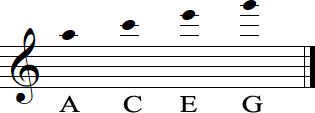
- 6th line: A
- 7th line: C
- 8th line: E
- 9th line: G
If you use the 5th line note as reference (F), there’s still the word “face”, plus a G.
Line notes above the staff has always a portion of the imaginary lines in their head.
Reading practice #3
Space notes above the staff
Observe and memorize the name and position of each space note:

- 5th space: G
- 6th space: B
- 7th space: D
- 8th space: F
- 9th space: A
If you use the 4th space note as reference (E), there’s still the acrostic sentence Every Good Boy Deserves Food, plus an A.
Space notes above the staff are always resting on a segment of the imaginary lines.
Reading practice #4
Reading practice #3 & 4

Line notes below the staff
Observe and memorize the name and position of each line note:

- 3 lines below the staff: F
- 2 lines below the staff: A
- 1 line below the staff: C
There’s still the word “face”, less an E. Even line notes below the staff has always a segment of the imaginary lines in their head
Reading practice #5
Space notes below the staff
Observe and memorize the name and position of each space note:
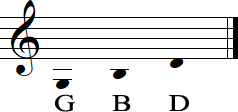
- Below 2 space under the first space: G
- Below 1 space under the first space: B
- Below the first space: D
There’s still the acrostic sentence Every Good Boy Deserves, without the word “Food”.
Reading practice #6
Reading practice #5 & 6
Reading practice: All notes

Now you have learned to read all natural notes (white keys on the keyboard), it’s time to introduce the concept of sharp and flat notes (black keys) but before that, you need to know something about intervals:
Intervals
Semitone and tone
An interval is the difference in pitch between two notes. The smallest interval is called a semitone (or half-tone).
For example, if you are looking at the key of G on a keyboard chart, the note G♭ is a semitone lower than G. This means that you need to play the black key between F and G to lower the pitch. Similarly, G# is a semitone higher than G, so you need to play the black key between G and A to raise the pitch. The interval between G and G# is a semitone, and the interval between G# and A is a semitone as well. The word “semitone” means “half-tone”: 2 half-tones makes a whole tone. In other words, the distance between G and A is called a tone.
Intervals on piano accordion keyboard
Now look how keys are arranged: there are groups of 3 and groups of 2 black keys that run along the entire keyboard. There is no black key between the white keys E and F, or between B and C. It may seem that the interval between two white keys is always a whole tone, like the interval between G and A, but it’s not true: the interval between E and F as well as between B and C, is actually a semitone.
This means that E# and B# are white keys because when you add a semitone to E, it becomes F, and when you add a semitone to B, it becomes C. This also means that F♭ and C♭ are white keys because when you subtract a semitone from F, it becomes E, and when you subtract a semitone from C, it becomes B. However, it’s important to note that E#, B#, F♭, and C♭ are not very common in sheet music.

Sharp and flat notes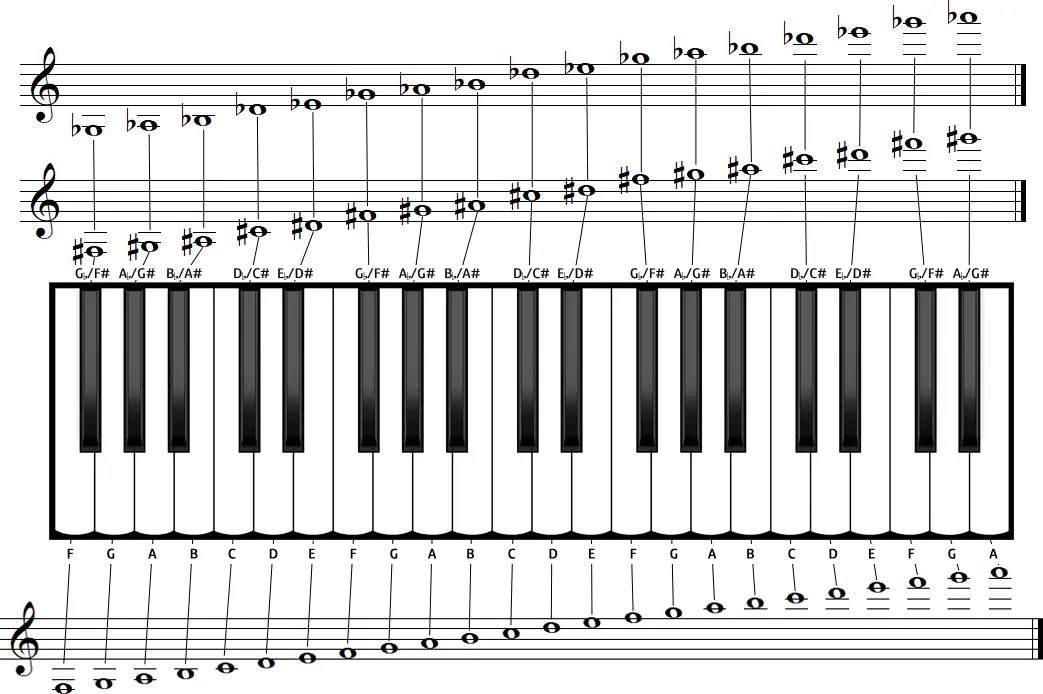
A sharp sign (#) placed before a note means that the note is a semitone (one half-tone) higher than the natural note. A flat sign (♭) placed before a note means that the note is a semitone lower than the natural note.
Accidental marks
Sharp (#) and flat (♭) signs are called accidental marks. Now, let’s see all others marks and signs that change a note pitch:
The double sharp sign 𝄪
A double sharp sign (x) placed before a note raises it a whole step (tone). Example: Fx = G
The double flat sign ♭♭
A double flat sign (♭♭)placed before a note lowers it a whole step. Example: A♭♭ = G
The natural sign ♮
A natural sign (♮)placed before a note cancels any previous sharp or flat in the same measure. Example: 
Enharmonic notes
Enharmonic notes are two notes that have the same pitch but different name.
For example, if you were to add a semitone to the note F, you would get the note F sharp (#). On the other hand, if you were to subtract a semitone from the note G, you would get the note G flat (♭). These two notes may have different names, but they are actually the same pitch. This is because they are both located on the same black key on a piano keyboard.
All black keys can be intended as sharp or flat notes but there are some other equivalences, for example:
D♭♭ = C
or
Ax = B
At this point, you know how to read pitch variation, you can say if a note is higher or lower than another one and you can give a name to every note inside and outside the staff.
Duration
Let’s learn how the duration is represented on a score.
These are 3 measures (or bars). A measure is a portion of the staff between two vertical lines, it divides the staff into units and groups notes and/or rests into subsets. Measures contain the exact number of beats indicated by the time signature at the beginning of the staff. Keep reading.
Note values
In music notation there are 7 different note values, each one has its own value.
Whole note:
it’s the note with the biggest value, 4 beats. This means that you have to play the whole note counting up to 4.
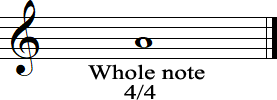
Half note:
it has a value of 2 beats, this is why it’s called half note. Play it counting 2 beats.

Quarter note:
it has a value of 1 beat so it’s 1/4 of a whole note.

Eighth note:
you need 2 eighth notes to make a quarter. Since you need 8 of them to make a whole note, it’s called eighth note (1/8). In this example, eighth notes are grouped into beam, the line used to connect consecutive notes.
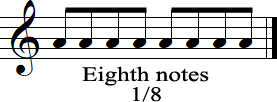
Sixteenth note:
it has a half value of an eighth note. If you split 1/8 in half, you get 1/16. Even sixteenth notes are beamed: the two flags of a single sixteenth became two lines that connect all notes in groups of four.

Thirty-second note:
like before, this value is half of the previous so dividing 1/16 by 2 you get 1/32

Sixty-fourth note:
1/32 : 2= 1/64. This is the smaller value and you need 64 sixty-fourth notes to make a whole note.

Note values Quiz
All these values are even, sometimes you need to play a note for 3 beats or for a quarter and a half for example. There are two way to extend note values:
1. Tie
The Tie is a curved line which connects two notes of the same pitch, indicating that the time value of the two notes is combined:
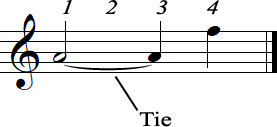
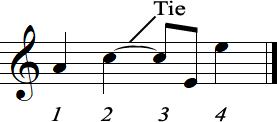
In the first example, there is a half note (2 beats) tied to a quarter note (1 beat), 2 +1 = 3 total beats. You have to play A for 3 beats then F for 1 beat.
In the second example, there’s a quarter note (1/4 of a whole note) tied to an eighth note (1/8 of a whole note): 1/4 + 1/8 = 3/8
Ties can connect even two notes of two different measures: ![]()
2. Dot
The other way to extend the duration of a note is by using the dot. In music notation, a dot placed right after a note, adds half of the value of that note.

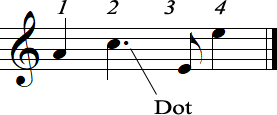
In the first example, there’s a dot near a half note: the dot extends the duration of the half note (2 beats) adding half of its value (1 beat): 2 + 1 = 3.
In the second example, we have a dot near a quarter (1 beat, 1/4 of a whole note), in this case, the dot adds half of the value of the quarter note: 1/4 + 1/8 = 3/8.
Time signature
The time signature is expressed by two numbers: a top number and a bottom number. You will find those numbers near the clef. The top number indicates the quantity of beats, the bottom number indicates the quality of beats (quarters, eighth, etc.).
The most common time signatures are:
4/4
also known as “Common time” (C)


4 four quarter-note beats in each measure: it is used for many different rhythms and it’s the most common time signature.
3/4

3 quarter note beats in each measure: this is the time signature for waltz and mazurka but is quite common even in pop music ballads.
2/4

2 quarter note beats in each measure: polka and marches are written in 2/4.
6/8

6 eighth note beats in each measure: this time signature is used in many rhythms from traditional “tarantella” to shuffle rock. It has two groups of 3 in the same measure: ONE, two, three, FOUR, five, six (ONE and FOUR beats accented). In tarantella and shuffle the 2nd and the 5th beat are omitted.
Rest values
Music is sound but it’s also silence. As for notes, there are 7 signs for rest values:
Whole rest:
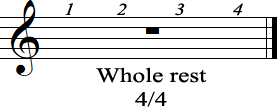
As the whole note, it has a value of 4 beats. The only difference is that these are 4 beats of silence.
Half rest:

This rest is very similar to the whole note rest but if you look carefully, it has a different position on the staff: the whole rest is below the fourth line and the half rest is placed above the third line. It has a value of 2 beats so to fill a 4/4 measure, you need two half rest.
Quarter rest:

These are four quarter rests. Each one has a value of 1 beat.
Eighth rest:
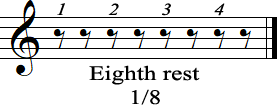
Eight of these rest fill a whole 4/4 measure. Each rest has a value of 1/8 (half a beat).
Sixteenth rest:

Thirty-second rest:

Sixty-fourth rest:

Dynamic
In music, the dynamic is the variation in loudness between notes or groups of notes, in other words: volume variation.
1. Dynamics are represented by some letters like:
- ppp which in Italian it means “pianissìssimo” = play very very soft
- pp which in Italian it means “pianìssimo” = play very soft
- p which in Italian it means “piano” = play soft
- mp which in Italian it means “mezzo piano” = play moderately soft
- mf which in Italian it means “mezzo forte” = play moderately loud
- f which in Italian it means “forte” = play loud
- ff which in Italian it means “fortìssimo” = play very loud
- fff which in Italian it means “fortissìssimo” = play very very loud
![]()
2. Gradual changes in volume are expressed using these Italian words:
cresc. which in Italian it means “crescendo” = increasing volume
decresc. which in Italian it means “decrescendo” = decreasing volume
dim. which in Italian it means “diminuendo” = diminishing volume
3. Hairpins (<>)are also used to express volume variations.
If the angle lines open up (< ) then it means you have to start soft and get gradually louder; if they close (>), then it means that you have to decrease the volume.

Conclusion
This post is just a resource to start reading the accordion notation, there’s much more to say about it but if you are a beginner, I think that this lesson has all you need. Obviously, you need also to practice: reading music is a skill that needs time so please, don’t worry.
This lesson can’t teach instantly how to read music notation. Learn how to read music is a slow process so be patient, keep doing the “reading practice” exercises and all other quizzes, I can guarantee that you will be able to read an accordion score very soon!
Author: Giovanni Lucifero



still learning to play